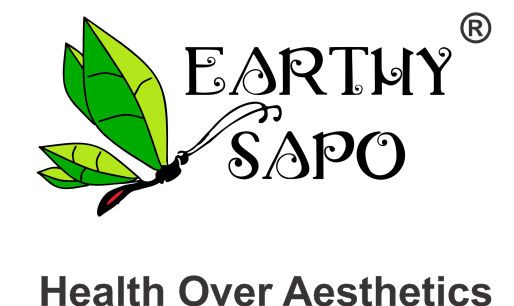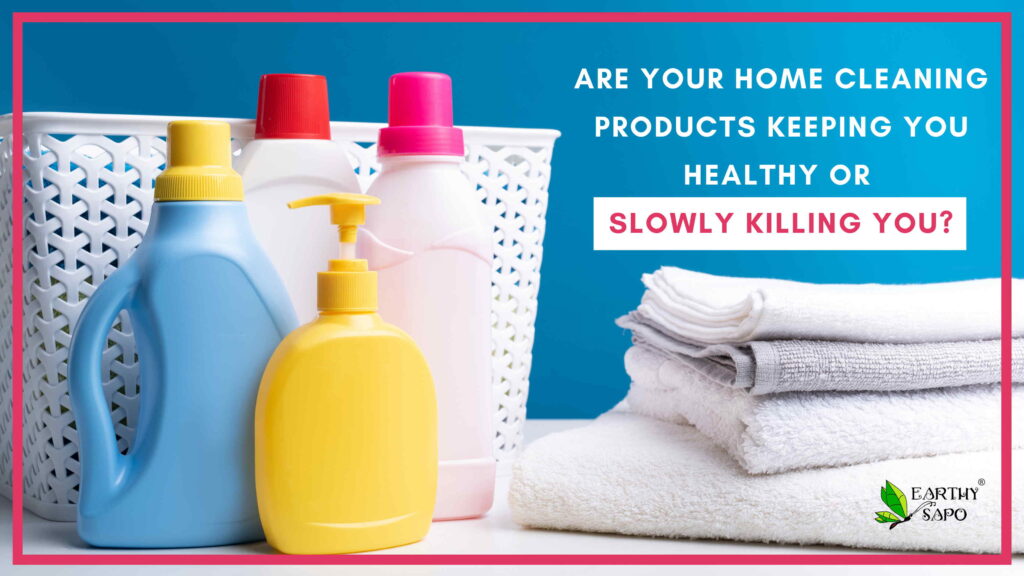Environment, Health & Wellness, Home Care
Are your home cleaning products keeping you healthy or are slowly killing you?
– By Soujanya Padikkal & Sheetal Kabra
Maintaining a clean house is an important factor for a healthy life. A variety of home care products like detergents, sprays, bleach, air fresheners, toilet cleaners, disinfectants etc are used by us to help keep our house clean and hygienic. But are they actually taking care of our health or are they stripping us of good health?
To know if a personal care product like a toothpaste or shampoo is safe for us, we check the ingredients list on the label. But have you ever checked the ingredients list of the home care products to estimate its safety? The answer is mostly no. The reason being that people are under the false notion that just because these home cleaning or home care products are not consumed internally or applied externally on our skin, they do not pose any health risks to us. We can wear gloves while using them to avoid complete skin contact, but what about other forms of contact like through air? Do we even realize that we could be actually ingesting them if traces of them remain on our dishes? Commercial homecare products contain chemicals that can affect our health adversely. Chemicals have the potential to enter our blood stream, penetrate our cells and cause damage away from the site of entry. Chemicals may not affect you immediately but there are high chances of it getting accumulated over a period of time, reveling is effects after years. But the main question is, do we even know what chemicals are incorporated in these products?
Even if you want to know the ingredients of the home care products, how will you find out? The labels do not list the entire ingredient list or worse do not list the ingredients at all! Check the labels of the various house cleaning products and you would know what I mean. It is interesting to know that Companies manufacturing these chemical-based home care products , are not required by law to give a detailed ingredient list on their labels. Only chemicals of known concern are required to be put on the label. So basically, there are no regulatory bodies that have a strong hold overlooking the production of household chemicals! So how are we claiming that these products are loaded with harmful chemicals? It is only through research done over the years by scientists that we know of the various chemicals that are incorporated in these products and the harm they cause to us! Lack of strict and regulated labeling norms not only deprives the consumers of making an informed decision, it also creates a wrong impression in their minds that these home care products are benign and pose no harm or threat to their health.
Unfortunately, the reality is far from this. Most of us are not even aware of the word ‘indoor pollution’ that is caused due to the home care products we bring home. A few minutes into cleaning bathroom floors, your skin starts to itch. Eczema is one of the most common effect seen because of the usage of these chemicals. The ever increasing cases showing developmental problems, reproductive issues, cancer, diabetes, hormonal problems has made the usage of household products dangerous for our health and not to forget the damaging impact on the environment (read more on this on our blog The Karma in Our Personal and Home Care Choices).
Let us take a look at some of the products commonly used at our homes and analyze how safe are we by using them:
- Dish wash cleaners and Laundry cleaners – These are used either in the form of soaps or liquids. They contain chemicals like sodium lauryl sulphate / sodium laureth sulphate (SLS/SLeS), phosphates, alkylphenols, oxygen based bleach, ,triclosan, formaldehyde, 1,4- dioxane among others.
- SLS/SLeS is the synthetic surfactant used in the detergent for lather and to remove oily stains. It known to cause adverse skin reactions.
- Phosphates are used to soften hard water and enhance the performance of the surfactant. While it is considered toxic free, it has huge environmental implications which in turn results in polluted drinking water and other associated health issues.
- Alkylphenols are used as emulsifiers (substance that helps two liquids mix), and have been found to be an endocrine disruptors. Further, studies show that their toxicity increases with time unlike other chemicals during degradation.
- Triclosan is a widely used as an antimicrobial agent in liquid gels and is an active ingredient of dishwashers. Studies show it harms a cell organelle – mitochondria (produces our body’s energy – ATP), can affect the immune system, cardiovascular system, it is an endocrine disruptor and can also result in anti-bacterial resistance due to prolonged usage.
- Formaldehyde is commonly used in detergents and cosmetic products as antibacterial agent and preservative. Formaldehyde is toxic and a known carcinogen. Even when exposed to low levels of it, it enhances your risk of cancer according to the CDC (Centre for Disease Control and Prevention). It also causes irritation of eyes and skin.
- 1,4-dioxane (sometimes just called dioxane) is found in detergents, but it’s not an intentionally-added ingredient. It’s a contaminant that is created when certain common ingredients are mixed together. 1,4-dioxane is an expected contaminant from a process called ethoxylation, when ethylene oxide is added to other ingredients to make them less harsh. A good example of this is SLS, which is harsh on skin. It’s often ethoxylated to convert it to SLeS; 1,4-dioxane is created in the process and SLS! It has been listed as a known or probable carcinogen by several scientific agencies. It has also been observed that acute inhalation exposure causes headache, drowsiness, irritation of skin, nose, throat and lungs.
- Household Bleach – Who doesn’t love cleaner and whiter when it comes to floors and clothes! Bleach is a chlorine based chemical and it definitely works but has a major impact on one’s health. The fumes from bleach when inhaled can cause serious breathing problems. It is a skin irritant and corrosive to eyes and lungs. It is dangerous if mixed with other household cleaners as chlorine gas is released which damages moist tissues like eyes, lungs leading to asphyxiation, and death.
- Toilet cleaners – mainly include hydrochloric acid (HCl), cetrimonium chloride, bleach, sodium hydroxide among others. All these ingredients are extremely corrosive and are intended to remove tough stains and also work as an disinfectant. They however, cause skin and eye irritation when they are exposed to their fumes. Inhalation of fumes while cleaning can lead to irritation of nose and throat, coughing, sneezing, shortness of breath. It can also induce an allergic reaction and inflammation of upper respiratory tract. Apart from these, they also pose severe environmental hazards.
- Drain Cleaners – sodium hydroxide is the main component of drain cleaners. Some drain cleaners use sulphuric acid instead. They are used as they are corrosive and break organic material well. However, like in use of bleaches and toilet cleaners, fumes from these chemicals are toxic and dangerous. Inhalation of the fumes causes coughing, choking, tightness in breath. The fumes of these chemicals can also get into the lungs causing pulmonary edema (accumulation of fluid in the lungs). Exposure to sodium hydroxide fumes can cause irritation to the skin and eye, sore throat and runny nose.
- Air fresheners- We are constantly exposed to them, be it at home, workplace or restaurants. They contain a number of chemicals like formadehyde, benzene, phthalates, styrene and volatile organic compounds (VOCs) i.e. substances that readily become vapor or gas. Air freshener chemicals have been linked to cancer (formaldehyde and benzene), endocrine disruption (phthalates) and neurotoxicity (styrene) by researchers. Studies done by researchers on US and Australian population observed that exposure to air fresheners or deodorizers caused migraines, skin problems, asthma, cardiovascular and immune system related issues. They can also be absorbed by furniture, carpets, walls and other surfaces; effecting you long after it has been used.
Many of the chemicals like triclosan, phosphates have been banned or their usage regulated in the US and few European countries. However, the situation in India is different. The usage of these harmful chemicals in home care products in not regulated and neither are the labeling requirements strict. In pursuance of the eco-labeling scheme known as ‘Ecomark‘ launched by the Government of India, in 1991 for easy identification of environment-friendly products, the Bureau of Indian Standards (BIS) had separately laid down the standards for eco-labeling of detergents in India. The specific and general requirements laid down by BIS for ecomarking of detergents states that they should not contain any phosphate, the surfactants used in the manufacture of household laundry detergent powders should be readily biodegradable and the products be packed in packages made of recyclable or biodegradable materials. Despite laying down this Ecomark plan which encourages phosphate-free environmentally-friendly detergents, not a single compliant product has made its way to the consumer! It is interesting to note that many of the international companies who manufacture phosphate free detergents for the international markets like US and Europe, absolve themselves of this responsibility in India, and continue to manufacture detergents with a high content of these chemicals.
Having and maintaining a chemical free clean house is possible if we shift to natural products which are sustainable and harmless. Using ‘green detergents’ that are made from natural, biodegradable and eco friendly ingredients and are free from synthetic and non-essential additives like perfumes, colour and brightening agents in minimal packaging, will go a long way in ensuring a cleaner and healthier environment.

